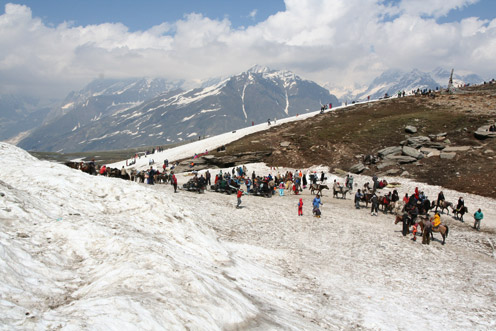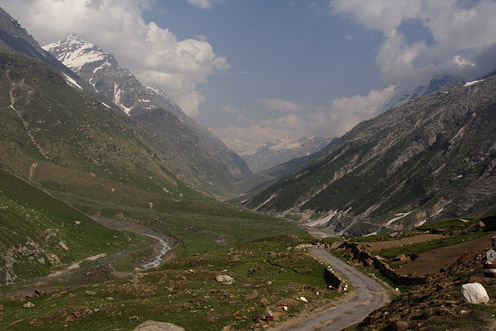The mountains raise so high that I have to bend down to have a look at the summits through my hotel window. I can see the bottom of the valley, but the river has carved a gorge for itself deep enough to hide the flow from the view. Lower slopes are green, with square fields of aloo-matar and willows along their edges. But it is brown and barren high up. On the high peaks and depressions of the slopes are bits of snow that have survived the summer.
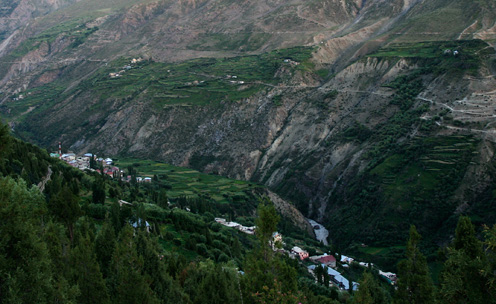
Keylong’s edifices look tiny against these giant mountains. Allow me some cliche here: standing high on the slopes of one of those mountains, they look like tiny matchboxes spread haphazardly on the floor. The town is a good stopover if you have your own vehicle and travelling to Leh at an easy place. It is not too high a place to sleep, and summers are reasonably warm. The great views are a bonus.
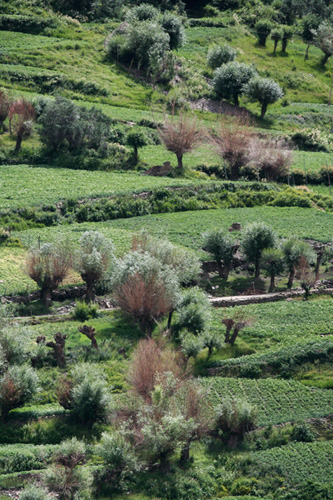
If you are charmed by the views or stuck (like we were) waiting for transportation for the way ahead, there is enough in Keylong to keep you occupied. The two monasteries near the town – Shashur and Kardang – are midway up the mountains on the opposing slopes. Lucky few (again, like we were) may end up arriving here on a day when a festival is on at the monastery. Celebrations here are usually tourist-free, unlike the crowded ones in Ladakh.
Most hotels in town are spread along the mall road. Being a popular stopover, the hotels tend to get full for most of the duration when Manali-Leh highway is open. If you haven’t booked ahead, the next option is to search at the ‘old bus stand’ on the Manali-Leh road, where the hotels tend to have rooms available.
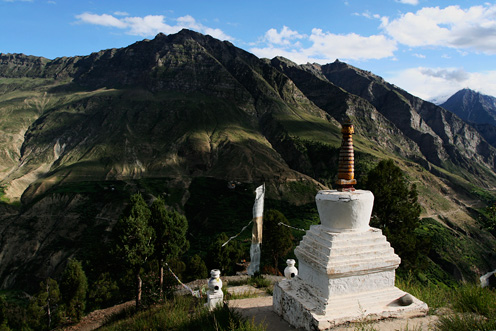
Landing up at Keylong and trying to find transportation for the way ahead can be hard. The luxury buses from Manali usually run full. The uncomfortable Delhi-Leh bus run by Himachal Road Transport Corporation is not exactly the best option, but even that can get filled up quickly. Drokpa Travel on mall road can book private cabs from Keylong or shared taxis leaving from Manali.
Ahead of Keylong, the road gently climbs up along Bhaga Valley and slowly makes its way to no man’s land.
Rohtang Pass is a place that marks many divides. To the south are the green slopes caressed by monsoons every year and to its north is a stark landscape often called the forbidden valley. Beyond Rohtang, the landscape begins to start resembling Tibetan, and so do the people. Temples give way to monasteries and Shiva makes way for Buddha. Apple orchards are replaced by potato and sweet peas. It is as if you just changed the DVD and a different movie started playing on the gigantic 16:9 screen.
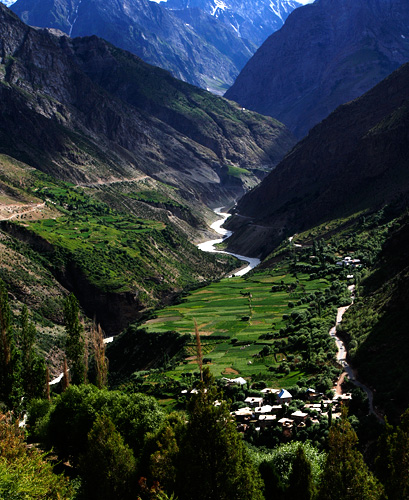
The fabulous setting of the town of Keylonw, Bhaga River and the road from Tandi
People north of Rohtang have an unusual pride about the altitude they live in. Every village along the way lays some special claims about its location. In Spiti Valley, a deviation on the Leh highway, people at Kibber Village once loved to call it as the highest permanent inhabitation in the world. When the record was broken somewhere else, they were not ready to give up. They came up with more possibilities instead: highest village with electricity, highest village with a motorable road, highest village with a post-office, and so on. A quick web search reveals all possible versions and may even give ideas to cook up new ones. Just below Kibber at the base of Spiti Valley, the petrol pump in Kaza doesn’t fall behind in making the ‘highest in the world’ claim.
Going past Keylong, probably every named place has something highest attached to it. It is only a matter of finding out highest ‘what’!? Indian Army takes bulk of the credits for creating all these highest hypes. In Pang, a tourist stopover on the way to Leh, is an army camp labeled as the “world’s highest transit camp.” Far north in Ladakh is Siachin glacier with its notorious claim for being the world’s highest battle field, where India and Pakistan have been fighting and wasting away lives and resources for a land that neither party can put to any good use. Once you have the privilege of making claims for world’s highest battlefield, the highest airfield is obviously not going to be far away. And Khardung-la, the world’s highest motorable pass doesn’t need any introductions. But Khardung-la’s days are probably numbered: everyone speaks of motorable passes in Ladakh and Tibet that raise much higher. I am sure they will find a new title for Khardung la when another pass officially becomes the highest motorable road.
That’s much digression from Rohtang Pass where we started from. It is a quick and steep descent from the pass, down to the valley of Chandra River. The small village of Khoksar next to the river is more a food court than a village. Dhabas line up the 100m or so length of the road, which is as long that the village spreads. A Himachal Pradesh Government PWD bungalow in the village may be open for visitors, but most people prefer to continue to Keylong. Despite the charm of Chandra River, Khoksar is not a pretty place and is too close to Manali for a halt.
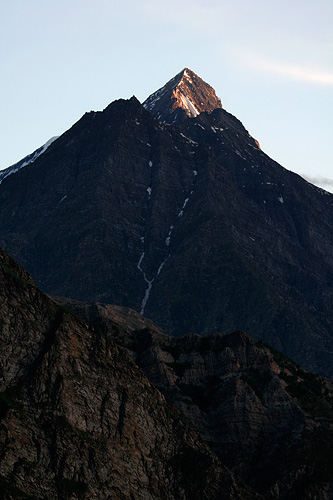
Mighty mountain peaks seen from Keylong town
The way further is parallel to Chandra River, going downstream after crossing the river at Khoksar. It is usually muddy and flows swiftly in the months of July and August – the peak season for travelling to Ladakh. Photographs taken in later months show it in a deep hues of blue, a color that eludes most people who are on their way to Ladakh. The tall peaks along the way tend to have last snow of the season, and many tall waterfalls come down from the steep hills to merge with Chandra.
Tandi, 10km before Keylong has the last petrol pump on the highway. The road here turns right and continues along the valley of Bhaga River. A sign at the confluence of Chandra and Bhaga reads [not verbatim; recreated from memory]: “Welcome to Tandi, the confluence of blue waters of Chandra and green waters of Bhaga.” Unfortunately, the colours are all mixed up with plenty of earth, and what is there to see is two muddy currents coming together into one.
Chandra and Bhaga have an interesting origin. They both begin at different faces of the mountain at the same location – Baralach la. Chandra flows east and then turns west traversing through the valley of Lahaul, while Bhaga flows south through Darcha and Keylong. They meet again in Tandi, like two long lost sisters getting to see and hug each other. More like we see siblings separated at birth rejoining in an emotional drama in a Kannada movie, with the lead actor playing two roles.
Keylong is a quick 20 minutes drive upstream Bhaga River. It is the place where most people prefer to spend the night on the way to Leh, as we found out on arrival.
People start from Manali at an unearthly hour of 2am. And they keep going and going and going, travelling nearly twenty hours to get to Leh. It seems like a senseless adventure to go in a cramped Tata Sumo in those testing altitudes; It seems like Leh will never come. But people do it: many Sumos leave for Leh everyday, packing passengers from Manali who don’t want to waste a day or spend more money by stopping on the way.
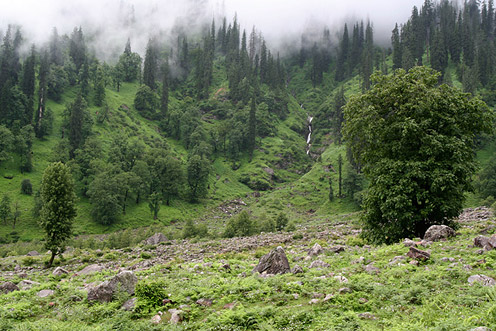
Verdant landscapes of Beas Valley
The initial part of the journey is pleasant. The road runs upstream of Beas River through a green valley, with tall mountains on both sides flaunting coniferous forests on their slopes. It slopes up gently for the first half hour and then steadily increases in gradient. Waterfalls run abundant on the near vertical slopes, emerging out of the snow trapped in depressions. The sheer scale of mountains in these parts are realized by tiny specs of shepherd-tents that look no bigger than a small dot on the slopes. It indeed needs no less than a collision between two continental masses to create formations of this scale and might. Its grandeur, size and fearsome weather can overwhelms the onlooker and instantly earn his or her respect.
The slopes of Manali-Rohtang Pass road remain green through the year in lower regions. The deodar forests give way to shorter vegetation higher up, and eventually it is just green grass spreading thinly on the surface. Streams run all over the place uncontrolled, released from the melting masses of ice. The pass is completely covered in snow in early summer and gradually melts away, with very little of it left when the monsoons arrive. As the first rains come in and snow is drained out from the higher regions, flowers burst out on the slopes, filling up every inch of the mountains with tiny dots of pink and yellow.
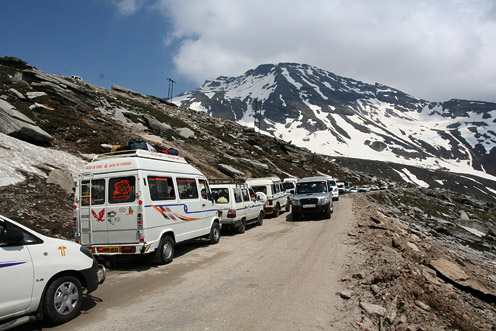
The road to Rohtang Pass (File Photo)
The last hour of the journey though, is much more than the romance with the mountain ranges. The rush of tourists in search of snow creates frequent traffic jams on the way up. Unmetalled surface can be slushy and hard to navigate. The thin mountain air and the half burnt diesel emissions from the pile of vehicle heading up is not exactly pleasant. It looks no different from peak hour traffic in congested roads of our cities, save for the views of the mountains here.
Tourists at Rohtang Pass (File Photo)
In summer months when there is still snow, Rohtang attracts large crowds excited about the snow. It’s a mad tourist trap that takes in thousands of people, followed by hundreds of vendors trying to keep the tourists comfortable and happy. The plateau on the pass turns into a big market place with long lines of shacks selling things from Aloo Paratha to skiing lessons. But later in the season when the slopes are bare (this is when the Ladakh season begins, in late June), there are just a handful of optimistic tourists searching for last of the snow.
Beyond Rohtang: Chandra Valley in Lahaul (File Photo)
However, there is a sea change in atmosphere on getting past Rohtang and entering into the valley of Chandra river in Lahaul region. The greenery that kept comapny disappears suddenly and the slopes appear brown and arid. Dhauladhar mountains (the mountain range that hosts Rohtang Pass) keep the monsoon at bay, allowing little precipitation and extending the summer days until October. The mass of tourists, the traffic and commotion dies down and makes way to silence. Verdant landscapes of Beas Valley make way to a stark beauty that has no parallels to scenery witnessed so far. It is here that the traveller begins to see first glimpses of barren landscape that Ladakh is, though Ladakh itself is still far away.







